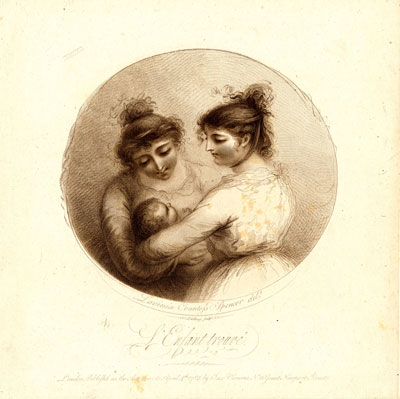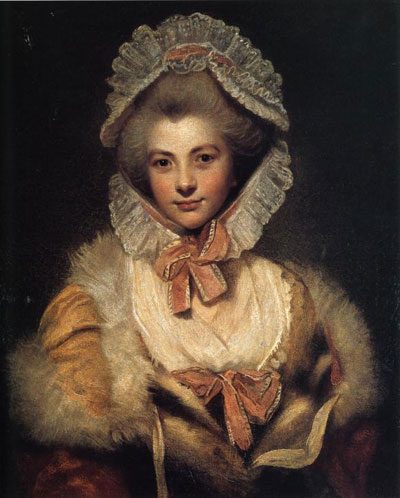L'Enfant Trouvé
This is the earliest of four stipple engravings by Gillray after drawings by the young Lavinia Spencer (1762-1831). The others include a pair of engravings published on the same day in 1787—The Happy Mother and The Tender Mother—and a more ambitious scene from a comic opera, Nina. (1792).

© Trustees of the British Museum
Lady Lavinia Spencer was the oldest daughter of the Irish peer Charles Bingham and his wife, Margaret Smyth Bingham. The Binghams seemed have had a strong interest in art. Margaret was recognized as an excellent copyist of other people's work and a portrait miniaturist in her own right. She was the subject of a painting by Angelica Kaufmann which portrayed her looking at a portfolio of prints. And of course Lavinia herself and her sister Ann were both subjects of well-known paintings by Sir Joshua Reynolds.

Portrait of Lavinia Bingham, Countess Spencer
[1782]
© Wikimedia
Surrounded by art and on speaking terms with some of the leading artists of her day,
it should come as no surprise that Lavinia would try her hand at drawing. And although only 23 when
A LARGE ASSORTMENT OF NEW PRINTS. Among which are several fine ones by Angelica Kauffman, Lady Spencer, Bunbury, Bartolozzi, Fuseli, West etc. all first impressions or proofs, and at the London prices.
And according to the London Public Advertiser, May 11, 1785,Pg. 4,
Lady Spencer's last effort with her pencil, which she calls L'Enfant Trouvé, has not been nearly so successful as her Two Moments of Reflexion and Imagination. The features of the female on the spectator's right hand, are such as shew to much disadvantage when seen in profile.*
In 1785, a drawing of two women holding a foundling would have been a generally safe bet as a subject for both Lady Spencer and Gillray (when working in this genre). The latter half of the 18th century is often dubbed the age of sensibility. Especially after the appearance of the hugely popular Man of Feeling in 1771, it was a time when sympathy for the weak, defenseless, and downtrodden was a badge honor. The depiction of a foundling baby would have had just the right emotional appeal, especially since Lady Lavinia had given birth to the first of her nine children in 1782.
How did Gillray come to be engraving a drawing by someone as socially prominent as Lady Spencer? Tim Clayton, in his excellent book, James Gillray: A Revolution in Satire notes that "There is something of a pattern to the patronage from major Whig families—the Lambs and the Spencers— that might owe something to Humphrey family patronage." But he also acknowledges that the connection "might be purely accidental and simply an appreciation of talent."
Since May of 1783, Gillray had been making a concerted effort to break into the serious art market with sentimental stipple engravings like Innocence, Remorse, and, more ambitously The Village Train. So Gillray already had demonstrable abilities and experience with these kinds of prints. All of these, however, had been published by Gillray's friend Robert Wilkinson. If Lady Spencer had approached Gillray directly, the odds are that he would have used Wilkinson as publisher.
It is more likely that Lady Spencer would have looked to Susanna Vivares to recommend an engraver. Vivares would have been known to her as the publisher of furniture prints based on pictures by Angelica Kauffman and Giovanni Cipriani, most often engraved by Bartolozzi. But her shop at 13 Great Newport Street was literally one minute away by foot from the address at #7 Little Newport Street that Gillray used on his trial business card created around this time. He must have known the area and would likely have visited her shop. Both Gillray and Vivares would have had an incentive for making a new connection. And however that connection came about, it seems to have worked. Lady Spencer's drawings continued to be engraved by Gillray and published by Susanna Vivares until Susanna's death in 1792.
* To clarify: There are two prints referred to in the Public Advertiser. One is Le Moment de L'Imagination; the other is Le Moment de la Reflexion. Both can be seen in one of two volumes in the Lewis Walpole Library entitled A collection of prints engraved by various persons of quality. But, alas, they are not individually digitized. The first of the prints was itself parodied by W. George in The Moment of Imagination published January 13th, 1785.
Sources and Reading
- Commentary from the British Museum on L'Enfant Trouvé.
- Draper Hill, Mr. Gillray The Caricaturist, 1965, p. 27
- Tim Clayton, James Gillray: A Revolution in Satire p. 75.
- "Lavinia Spencer, Countess Spencer," Wikipedia
- "Margaret Bingham," Wikipedia
- "Susanna Vivares," British Musuem
Comments & Corrections
NOTE: Comments and/or corrections are always appreciated. To make that easier, I have included a form below that you can use. I promise never to share any of the info provided without your express permission.